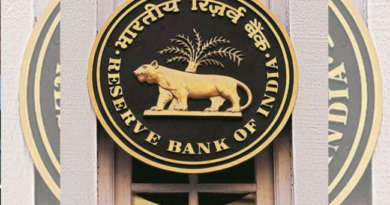BEYOND THE RATE HIKE:UNDERSTANDING THE EFFECTS OF MONETARY POLICY TIGHTENING IN INDIA
Abstract:
India, like many nations, faced rising inflation in 2021. To combat this, the MPC implemented a series of aggressive monetary tightening measures. This study investigates the effectiveness of these policies in controlling inflation and analyzes their impact on various economic aspects. The findings reveal a successful decline in inflation, achieved through reduced liquidity, increased money market yields, and a shift in government securities markets. The introduction of External Benchmark Lending Rates (EBLR) improved transmission of policy changes to bank lending rates. However, a trade-off between inflation control and economic growth emerged, with GDP growth experiencing a slowdown. The paper concludes that while the MPC’s actions effectively curbed inflation, achieving a “soft landing” for the Indian economy requires close monitoring and potentially adjusted future policies.
Introduction:
Globally Inflation started rising post April 2021 and went above the target range set by most of the Central Banks. It had remained low and dormant for a substantial duration since the global financial crisis. CPI inflation in developed countries such as US, UK and Euro zone, began to exceed their traditional target of 2% and continue to stay at these elevated levels till recent time. The initial rise in inflation was primarily due to increase in demand from easing lock down restrictions, rise in profit margins of corporates and recovery in energy and commodity prices etc. Initially, the central banks felt that this sudden rise in inflation would be temporary and transitory, so they continued with low interest rates and accommodative stance. However, with passage of time global central banks got convinced that the inflation has become persistent, and they immediately needed to front load monetary tightening.
Bank of England (BoE) was the first to raise benchmark rates in December 2021, followed by US Federal Reserve and European Central Bank (ECB) in March 2022 and July 2022 respectively. Inflation got spooked on account of rise in geopolitical tensions post outbreak of Ukraine-Russia War. This resulted in sharp rise in the global prices of crude, food and other important commodities coupled with further deterioration in the supply chain. As a result of this globally inflation spiked and stood elevated. The central banks across the world addressed the situation with aggressive and simultaneous monetary policy and quantitative tightening.
India also witnessed rising trend in inflation from October 2021 and become resolute after it went above 6% from January 2022 and continued to stay at those levels for next 5 consecutive quarters. The situation in India deteriorated further on account of Russian-Ukraine war as food and fuel inflation spiked resulting in rise in CPI inflation as they carried a joint weight of 52.60% in the CPI basket. This forced the Monetary policy Committee (MPC) to follow other Central Banks with its first-rate hike in an off-cycle meeting in May 2022. This was followed by consecutive rate hikes with repo rate increasing cumulatively by 250 bps in the next 6 consecutive policy meetings, from May 2022 to February 2023. The MPC has maintained status-quo in last seven policy meetings till April 2024.
Inflation moderation has taken place both globally and domestically from its peak in 2022. However, it remains slightly higher and above the target set by various central banks. In March,2023 the financial markets in US were jolted with banking failures and the fear of financial contagion. So, to control the situation central banks started adopting a less aggressive policy path, which comprised of pausing rates and possibility of rate cuts in case inflationary pressure eases further in near term. The expectation of rate cuts coupled with the idea that the global economy would not be entering recession, boosted the financial market across the globe. However, there is still lot of uncertainty about the path that the data dependent Central banks are likely to follow to decide the timing and quantum of future rate cuts.
Impact of Monetary Policy Tightening on various economic variables:
a) On System Liquidity
MPC in the current regime of policy tightening has changed its stance to withdrawal of accommodation from ultra-accommodative. The Central Bank indicated that it would pull-out system liquidity in a calibrated and smooth manner. There was gradual decline in liquidity surplus generated during Covid because of monetary easing. It started declining from the level of ₹ 6.6 trillion in April 2022 to ₹ 1.50 trillion in by April 2023. The banking system liquidity turned into deficit position from September 2023. This warranted RBI to inject net liquidity on short term. It was clear that RBI’s intention by means of its liquidity management was in sync with its stance and effective policy rates. This supplemented and enabled decline in inflation on account of faster transmission of monetary policy. Figure 1 shows the movement in system liquidity during FY24.
b) On Money Market: Impact on Yield Curves of T-Bill & CD
The impact of monetary policy tightening was witnessed across various tenures of short-term money market instruments. The yield curves for both T-Bills & Certificate of Deposits (CDs) have moved higher by around 300bps across tenors from April 2022 till date. The movement of yields for T-Bills & CDs across tenures of 3-months, 6 months, and 1 year from 31/03/22 to 25/04/24 is as follows:
Movement in yield for T-Bills
| Tenor | 31/03/2022 (%) | 25/04/2024 (%) | Movement (in bps) |
| 3 months | 3.77 | 6.93 | 316 |
| 6 months | 4.20 | 7.03 | 283 |
| 9 months | 4.45 | 7.06 | 261 |
Movement in yield for CDs
| Tenor | 31/03/2022 (%) | 25/04/2024 (%) | Movement (in bps) |
| 3 months | 3.89 | 7.20 | 331 |
| 6 months | 4.17 | 7.17 | 300 |
| 9 months | 4.48 | 7.46 | 275 |
Because of narrowing of interest rate spreads with increasing tenor, slight flattening in the yield curves of T-bill and CD curves was observed. The monetary policy in April 2024, did not impact the T-bill and CD curves. The yield softening has taken place in the last few months due to inline fiscal deficit, easing liquidity crunch and expectations of rate cut. Figures 2a,2b depict the yield curves for T-Bills and CDs respectively.
c) Government Securities Market:
The G-Sec market, which is deep, liquid, and vibrant performs a major role in the growth of any economy. It establishes risk-free rates, that act as benchmark for pricing of instruments in various segments of debt market. It also plays an important role in the monetary policy transmission and enables the government in meeting its financial requirements. RBI has been continuously working to ensure development of this market in our country. The G-Sec yield curve also experienced considerable upward shift on account of monetary policy tightening coupled with decline in surplus liquidity in the system.
Recently, softening of bond yields has taken place on account of multiple factors such as decline in liquidity deficit, government likely to continue on the path of fiscal consolidation and the expected inclusion of Indian G-secs in the Emerging market Sovereign bond indices. Significant flattening of the sovereign yield curve occurred over medium to long term maturities. This can be explained by events factored in by market players such as expectation of lower levels of inflation and prudent fiscal consolidation in long term. The flattening of the G-Sec yield curve significantly isolates the large investment portfolio of financial institutions from interest rate risk and related financial instability. Figure3 highlights the movement in G-Sec yields on account of monetary tightening.
d) Deposit & Credit Portfolio:
In October 2019, RBI introduced External Benchmark Lending rates for SCBs which was a new floating rate benchmark. The purpose of the new benchmark was to ensure quick and efficient transmission of monetary policy to financial markets. This benchmark was to be used by the SCBs in pricing of their MSME and new retail loans. In order to promote this new benchmark banks provided their retail customers with an option to migrate their outstanding loans based on marginal cost-based lending rate (MCLR) to EBLR. RBI gave freedom to Banks to choose the underlying for arriving at their EBLR, which can be either any money market rate such as yield on T-Bills or the policy repo rate. Currently, in 80% of EBLR loans the benchmarking is done to policy repo rate. This results in automatic change in lending rates for banks whenever MPC tweaks repo rate.
The total share of EBLR based loans has increased to 56.20% in December 2023 from 9.1% in March 2020, while during the same period MCLR based loans have declined from 78.30% to 39.40%. The Banks have significantly improved transmission and transparency in setting of rates for its credit portfolio. This highlights that transmission has improved significantly, which improves the transparency in rate setting by the banks. The share of private and foreign banks in EBLR linked loans is higher (figure 4 as on Dec 2023 RBI data) which could be on account of higher interest rate discounts offered by foreign and private banks during Covid period to migrate their customers from MCLR to EBLR.
The transmission of policy interest rates in the current tightening cycle, has been effective for both deposit and credit market. This sets the tone for bringing in the right balance in spending by consumer and businesses. The change in deposit and lending rates for SCB’s on account of monetary tightening since April 2023 to March 2024 as per RBI data is as follows:
| Sl.No | Weighted Average Term deposit rates | Weighted Average Lending rates | ||
| Fresh Deposits | Outstanding Deposits | Fresh Loans | Outstanding
Loans |
|
| 01 | +259 bps | +185 bps | +186 bps | +111 bps |
e) Inflation:
During the last three years, India witnessed high and stubborn inflation. The WPI inflation averaged around 13 per cent between April 2021 to September 2022. The level being highest in over a decade, primarily on account of lifting of Covid restrictions leading to opening of economies and Russia-Ukraine war. It has been historically observed that spikes in wholesale prices normally indicate “inflation in the rising” and the same turned true as retail inflation rose substantially. The CPI index from January 2022 to September 2022 stood around 7%. The core inflation (it excludes food and fuel inflation) consistently stayed above 6 per cent for almost every month between May 2021 to March 2023. MPC started increasing policy rates from May 2022 and till April 2023 the repo rate was increased by 250 basis points and then paused.
The long pause of policy rate at 6.50% since April 2023 and RBI’s emphasis on draining out liquidity from the system in accordance with its stance of “withdrawal of accommodation” has to a large extend improved the anti-inflation credibility of monetary policy and the central bank. These steps have helped to break the vicious circle of wage-price spiral which results into transmission of inflationary pressures rising from higher food inflation to rise in core inflation. There has been continuous decline in core inflation since January 2023, which as on March 2024 hovers around record low levels of 3.50%.
As economic growth of our country is not showing any adverse signs on account of current policy rates, so we feel that RBI is unlikely cut policy rates in a hurry. In a post policy press conference in April 2024, the Governor indicated that India’s potential growth has likely risen given 8% GDP growth over the last three years. This indicates that neutral real rates have risen, providing policy space to remain on pause, for further clarity on food inflation risks and Fed policy.
f) Impact on Economic Growth:
The monetary policy tightening both globally and domestically had a considerable impact on India’s economy, as it clearly highlighted that the prime objective was of price stability compared to output stability. India’s GDP growth declined from 9.7% in FY22 to 7% in FY 23, primarily on account of slowdown in Private Final consumption expenditure (PFCE), Government Final Consumption Expenditure (GFCE), and Exports in goods and services. However, GDP is expected to recover to 7.6% in FY 2023-24, supported by buoyancy in Gross Fixed Capital Formation (GFC).
The quarterly released national income data more clearly highlights the lagged effect of tight monetary policy followed by an interest rate pause. The annualized quarterly GDP and GVA growth dipped from a high of 12.8% and 11.3% respectively in June quarter of FY23 to reach 4.3% and 4.8 % in the December quarter of the same year. This was followed by an economic revival from June quarter of FY24 as both GDP and GVA growth rebounded to 8.4% and 6.5% respectively in December quarter of FY24.
Now the question arises that with economic growth expected to be around 7% in FY25 with slowdown in global economy, it implies that demand on domestic front is likely to remain strong. So, if inflation is cooling off by slowing demand down on account of the current monetary policy, then next year with declining demand how can GDP growth continue to be high? then how likely is that instead of declining, inflation may rise again. It means that RBI is expecting that the policy rate transmission is not yet complete, and it would take few months for it to work through various channels, which would result in decline in demand.
Conclusion:
Central banks across the globe are majorly continuing with their tight monetary policy stance to bring inflation back to their respective targets. This act has also been complemented by the Governments across the world by taking steps to ease the supply side pressure so as to arrest inflation arising from high prices of commodities, food, and energy. Some of the major central banks such as Federal Reserve, ECB, BoE have continued to pause their policy rates while indicating rate cuts which would be data dependent. BoJ has also abandoned its negative interest rate policy and first time in last 17 years has increased the policy rates from -0.1 to 0.1% coupled with reduction in the amount of monthly quantitative easing. This clearly indicates that even the Japanese central bank is on the path of hiking interest rate and quantitative tightening which marks a shift from its decade long ultra –loose monetary policy.
Interest rates on fresh rupee deposits rose by 259bps, in comparison to rise in rates for fresh rupee loans in the tune of 186bps. This clearly indicates that rate transmission to deposit market has been higher relative to the credit market. The introduction of EBLR has significantly improved the monetary transmission of rates in Indian banking industry for loan pricing. However, the current monetary tightening phase has witnessed subdued deposit growth in comparison to credit growth, which is negatively impacting the bank NIM’s. In the initial stages of tightening credit growth was decelerating, but with pause and expectation of cut in policy rate it has again gained momentum.
RBI in a series of sudden and to front-load policy rate hiked it for a cumulative amount of 250bps from May 2022 to February 2023 and paused the rates thereafter. The main objective behind this action was to eliminate inflationary expectations thereby preventing persistency in core inflation which was on account of consistent high food and fuel inflation. The approach to increase rates quickly and in large quantum adopted by majority of central banks was to send a clear signal to the public and market that they are committed to rein in inflation back to the target at a quick pace. This helped central banks to improve their credibility as an inflation fighter, which increases their policy effectiveness.
Our central banks tight monetary policy did impact the economic parameters of inflation and growth, though with a lag. Headline CPI and core inflation moderated to below 6% and as of March 2024, they are currently hovering at 4.85% and 3.50 % respectively. A significant role has been played by global monetary tightening in moderation of inflation in India, especially WPI inflation which is currently at 0.53%. Our GDP growth also witnessed decline from 9.7% in FY22 to 7% in FY23, but it is expected to improve to 7.6% in FY24.
Advanced economies such as UK, Euro zone are showing signs of slowing economic growth as an after effect of sharp rise in the policy rates. However, inflation still remains above the 2% target, and the last leg of disinflation process is expected to be slow and prolonged. However, US is the only developed economy which is experiencing sustained economic growth, adequate employment generation and declining inflation. The current economic data has increased the likelihood of a soft landing coupled with mild recession in CY2024.




